Characterization of the intestinal cancer stem cell marker CD166 in the human and mouse gastrointestinal tract
- PMID: 20826154
- PMCID: PMC2997177
- DOI: 10.1053/j.gastro.2010.08.053
Characterization of the intestinal cancer stem cell marker CD166 in the human and mouse gastrointestinal tract
Abstract
Background & aims: CD166 (also called activated leukocyte cell adhesion molecule [ALCAM]) is a marker of colorectal cancer (CRC) stem cells; it is expressed by aggressive tumors. Although the presence of CD166 at the tumor cell surface has been correlated with shortened survival, little is known about its function and expression in normal intestinal epithelia.
Methods: We characterized the expression pattern of CD166 in normal intestinal tissue samples from humans and mice using immunohistochemisty, flow cytometry, and quantitative reverse-transcriptase polymerase chain reaction. Human and mouse intestinal tumors were also analyzed.
Results: CD166 was expressed on the surface of epithelial cells within the stem cell niche and along the length of the intestine; expression was conserved across species. In the small intestine, CD166 was observed on crypt-based Paneth cells and intervening crypt-based columnar cells (putative stem cells). A subset of CD166-positive, crypt-based columnar cells coexpressed the stem cell markers Lgr5, Musashi-1, or Dcamkl-1. CD166 was located in the cytoplasm and at the surface of cells within human CRC tumors. CD166-positive cells were also detected in benign adenomas in mice; rare cells coexpressed CD166 and CD44 or epithelial-specific antigen.
Conclusions: CD166 is highly expressed within the endogenous intestinal stem cell niche. CD166-positive cells appear at multiple stages of intestinal carcinoma progression, including benign and metastatic tumors. Further studies should investigate the function of CD166 in stem cells and the stem cell niche, which might have implications for normal intestinal homeostasis. CD166 has potential as a therapeutic target for CRC.
Copyright © 2010 AGA Institute. Published by Elsevier Inc. All rights reserved.
Figures
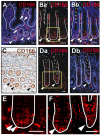
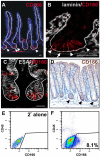
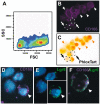
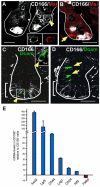
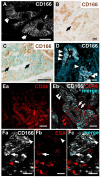
References
-
- Cancer Facts & Figures 2008. American Cancer Society; Atlanta: 2008.
-
- Cho RW, Clarke MF. Recent advances in cancer stem cells. Curr Opin Genet Dev. 2008;18:48–53. - PubMed
-
- Pardal R, Clarke MF, Morrison SJ. Applying the principles of stem-cell biology to cancer. Nat Rev Cancer. 2003;3:895–902. - PubMed
-
- Nowell PC. The clonal evolution of tumor cell populations. Science. 1976;194:23–8. - PubMed
Publication types
MeSH terms
Substances
Grants and funding
- R01 CA118235/CA/NCI NIH HHS/United States
- T32 HL007781/HL/NHLBI NIH HHS/United States
- CA106195/CA/NCI NIH HHS/United States
- U24 DK085532/DK/NIDDK NIH HHS/United States
- T32 HD049309/HD/NICHD NIH HHS/United States
- R01 DK068326/DK/NIDDK NIH HHS/United States
- DK068326/DK/NIDDK NIH HHS/United States
- HL007781/HL/NHLBI NIH HHS/United States
- T32 CA106195/CA/NCI NIH HHS/United States
- HD049309/HD/NICHD NIH HHS/United States
- U01 DK085532/DK/NIDDK NIH HHS/United States
- CA118235/CA/NCI NIH HHS/United States
- U01 DK085525/DK/NIDDK NIH HHS/United States
- DK085525/DK/NIDDK NIH HHS/United States
LinkOut - more resources
Full Text Sources
Medical
Research Materials
Miscellaneous

